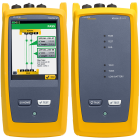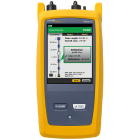Insertion Loss Should Be a Positive Number
2019년 1월 8일 / General, 101 learning, Installation and testing, Upgrading and troubleshooting, Best Practices
Insertion loss, or the loss of signal that happens along the length of a fiber optic link, is expressed in dBs and should always be a positive number. But it can be a negative number (which isn’t a good thing).
Return loss, which measures the amount of light reflected back toward the source, is also expressed in dBs and is always a positive number. A high return loss is a good thing and usually results in low insertion loss.
Reflectance, which also measures reflection and is expressed in dB, is a negative number. High reflectance is not a good thing.
Confused? Don’t feel bad — we may be talking fourth grade math here, but even PhDs are confused. All of these positive, negative, higher and lower dB results cause plenty of confusion (and disagreement) among even the most experienced professionals in our industry.
When Insertion Loss Measurement Yields a Negative Value
The most commonly measured performance parameter on a fiber optic link is insertion loss. It is a natural phenomenon that occurs for any type of transmission — electrical or data — and the longer the cable, the greater the loss. Loss also occurs at connection points along the way, such as connectors or splices.
Insertion loss is expressed in decibels, or dBs, and should be a positive number; it indicates how much signal was lost by comparing input power to output power. In other words, signals always come out smaller than they go in. The lower the number, the better the insertion loss performance. An insertion loss of 0.2dB is better than an insertion loss of 0.4dB.
There are, however, moments when insertion loss can appear as a negative value. But wouldn’t a negative value indicate a gain in signal? How can this be possible?
A negative insertion loss indicates a problem, one of which is often improper reference setting. For example, if a reference cable is dirty when setting the zero reference, and then cleaned before testing, the insertion loss could show a gain and potentially be indicated with a negative number.
Negative loss, or "gainers," can also occur due to differences in connected fibers. If the two fibers have different backscatter coefficients (a fancy term for information about the relative backscatter level of the fiber), more light can be backscattered after a connection rather than before the connection. If you’re only measuring in one direction, this can cause your OTDR to show a loss value that is less than it actually is, which could show up as a negative value.
But wherever there's a gainer, there's a loser. While transmitting in one direction may cause the gainer, when the measurement is taken in the other direction where less light is backscattered after the connection, the measured loss is greater than the actual loss. That’s precisely why industry standards require measuring in both directions, otherwise known as bidirectional testing. The two measurements are averaged together to give you the actual loss. The Fluke Networks OptiFiber® Pro does this automatically using its SmartLoop feature.

The Inverse Confusion
The other commonly measured performance parameter on a fiber optic connection is return loss. It is a measurement of the amount of light injected from the source compared to the amount of light reflected back toward the source. Expressed as a positive number in dBs, the higher the number, the better the return loss performance — a return loss of 60dB is better than 30dB. To remember that a higher return loss value is better, consider that if none of the light injected from the source signal was reflected back, there would be an infinite return loss.
And then we have reflectance, which measures the amount of back reflection created by a reflective event (i.e., a connector) compared to the amount of light injected — essentially the inverse of return loss. It too is expressed in dBs but is a negative number. The lower the number (remember we’re talking negative here), the better the reflectance: reflectance of -60dB, for example, is better than -30dB. OTDRs typically use a negative value for connection reflectance.
It’s not just the positive dB value for return loss and the negative dB value for reflectance that causes confusion. There is also plenty of confusion in the terminology itself, as the two terms are often incorrectly used interchangeably. That’s because return loss and reflectance both describe back reflection at a connector pair. However, the signs are different. You can see why when you look at how they are calculated:
Return Loss = 10*log (incident power/reflected power) in +dB
Reflectance = 10*log (reflected power/incident power) in -dB
Better Is Always Better
The confusion between positive return loss and negative reflectance means that you may see manufacturers specify a negative value for return loss when they really meant reflectance. And when a return loss value is referred to as higher, you might think that means a connector has more reflectance — especially since when we hear “higher” in our industry, we tend to think that means worse.
That’s precisely why we recommend avoiding the words “higher” or “lower” when it comes to values in dB, especially since dB is a unit of measurement used to express a ratio. What we should really be using to describe the values is “better” or “worse.”
If you simply remember that numbers closer to zero are better for insertion loss, and numbers further away from zero are better for both return loss and reflectance, you’ll be right. But in reality, you don’t really need to think about the actual values: our CertiFiber® Pro and OptiFiber® Pro will tell you clearly if your results are good or bad (i.e., better or worse).







